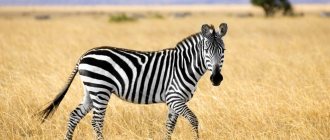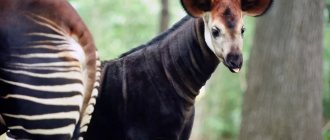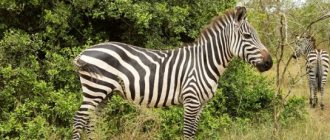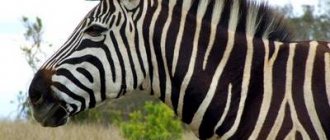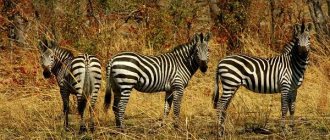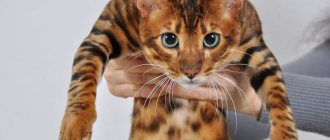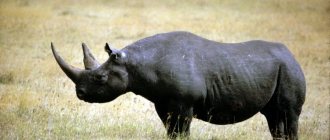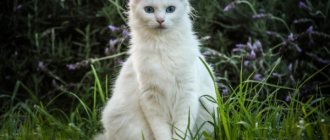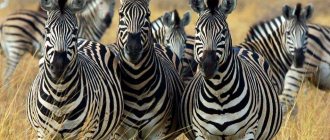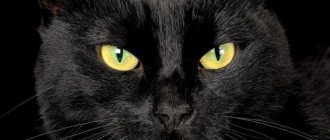History of the discovery of the species
The first acquaintance of Europeans with these unusual animals occurred only at the end of the 19th century. Traveling through the forests of the Congo Basin, British journalist and African explorer Henry Stanley noticed that the locals reacted absolutely calmly to his horses. Moreover, the pygmies explained that similar animals were found in their forests. Somewhat later, Sir Harry Hamilton Johnston, the famous English explorer of Africa, heard about these mysterious animals. In 1900, when he was governor of Uganda, he was given a sword belt made from the skin of an animal called okapi by the locals, and a year later he received the skin and two skulls of the animal as a gift. Laboratory research carried out at the Zoological Society of London confirmed the existence of a new animal and its relationship with the giraffe. At the end of 1901, the new species was given the name "okapi", or "Johnston's okapi".
Okapi behavior and nutrition
Okapi prefer a solitary life. Males and females mark the boundaries of their territory and carefully guard their allotments. Males live alone, and females live with their cubs. Animals are active during the day, and at night they hide in the thickets.
Okapi live at an altitude of 500-1000 meters, and in the eastern zone they rise even higher - into mountain tropical forests. Okapi's fur is able to repel water, thanks to this the animal does not get wet during the rainy season, the water simply rolls off to the ground.
Okapi feed on grass, leaves, fruits, ferns and mushrooms. Animals can also eat poisonous plants. In addition, okapi eat charred trees that have been burned by lightning. Representatives of the species eat brackish red clay near rivers and streams, which contains mineral salts.
Female okapi with baby.
Okapi at the zoo
There are 160 individuals of these animals in zoos around the world. They are transferred to be kept in captivity only if certain requirements are met, namely, the creation of living conditions that are as comfortable as possible and close to natural. Being quite anxious and timid animals, okapi easily fall into a state of stress, stop eating, and sometimes even drink. At the same time, with a gentle and trusting attitude, over time they turn into tame animals. Despite their increased sensitivity to any changes in climatic conditions, these animals can live in captivity for up to 30 years. However, they feel less comfortable in zoos in northern countries with cold winters.
Do you know which animals have stripes?
There are not so many striped animals. You can count only about 30 species with a similar coloration. Of course, the first animals that come to mind when searching for an answer to the question of which animals have stripes are our pets – cats. In the cat family, several other species fall into this category.
Striped animals
1. Tigers. Their fur is 11 cm long in winter, and only 2 cm in summer. These are very large animals, their body length reaches 3 meters.
2. Ligers. There are other animals of the cat family that have a similar color. They are called ligers (a hybrid of a tiger and a lion). These are very large and heavy animals, weighing twice as much as a lion.
3. The musky cat, which lives exclusively on the island of Madagascar, has nothing in common with the cat family. This ferocious animal is a small civet from the civet family. It is “lined” with black and white stripes from head to paw tips. But the most valuable thing about this animal is its aromatic musk, which is produced by special glands and is used by local residents in perfumery.
4. Catta lemurs are also sometimes classified as lined felids when answering the question of which animals have stripes. Perhaps this is due to the fact that they have a similar color. However, they are, in fact, closer to monkeys than to cats. This is the most interesting animal with a striped tail, which is their information organ.
5. The striped hyena lives in both North Africa and Asia. This is quite a large animal. Hyenas weigh about 60 kg and are 90 cm tall. They prefer a nocturnal lifestyle and are scavengers, for which noble lions and tigers simply hate them.
6. Raccoon dogs. These animals are rarely remembered by anyone when thinking about the question of which animals have stripes. This animal looks like a striped raccoon, but they are not even related. He has a kind of “mask” on his face, and the rest of his body is covered with stripes.
7. Raccoons are also classified as “mustachioed-striped.” They are rightly called the cleanest animals, because before eating the food they have caught, they rinse it thoroughly in water. Scientists still have not been able to understand where this habit comes from.
8. How can one forget about zebras when answering the question of which animals have stripes? These are the most famous of the striped animals.
9. Couscous. Small animals living in Australia. They are related to possums. They can hang on trees for hours, even fly from branch to branch.
10. Mongoose. Who doesn’t remember the legendary Riki-Tiki-Tavi - the hero of Kipling’s fairy tales? This is a small animal that lives in India, which actively fights snakes and also has a striped color.
11. There are also birds on the list. The tawny owl is a barred owl with a long tail and an unusually loud voice. She lives in North America.
12. The striped rattlesnake is a snake with a so-called rattle on its tail, which consists of rings resulting from molting. This is a very fast and poisonous snake, but also very lazy.
13. The striped tenrec is very similar to a hedgehog. It has a very small size - 15 cm. These animals live in Africa.
14. Meerkat. Children and adults will probably remember the character from the cartoon “The Lion King” - Timon. This is the meerkat - a striped animal that lives in the Kalahari Desert.
15. Monitor lizards resemble dinosaurs. So, among them there is also a striped species. These are very large semi-aquatic animals. Their skin is used as raw material for making various accessories.
16. Striped animals also include black and white skunks, which live in North America.
17. The marmoset is the smallest monkey in the world, with a body length of no more than 12 cm, and its tail is 15 cm. It can also be striped.
18. There are many fish with a similar color, for example, zebra lionfish, barb and others.
You should know it
- International scientific name: Okapia johnstoni.
- Conservation status: endangered species.
- Characteristics: the height at the withers of an adult male reaches 150-170 cm, while females are slightly taller, the animal’s body length is 2 m, weight is about 250 kg.
- This is interesting: the okapi's only habitat is dense tropical forests in the Congo River basin; however, even in this territory it is impossible to establish the actual number of these animals in the wild due to their increased secrecy and timidity, and the estimated number is 35-50 thousand individuals.
Amazing okapi: a rare giraffe with a short neck and zebra legs
Okapi is a full member of the giraffe family, just like its famous relative. But due to its secretive lifestyle and local distribution, few people know about it. Meanwhile, this beautiful animal is worthy of no less fame than the giraffe.
The okapi is the only species of the okapi genus that can be found exclusively in the Democratic Republic of the Congo. Okapi live in dense tropical forests, untouched by civilization. These are very shy animals leading a hidden lifestyle. For this reason, and also because military operations are ongoing in the Democratic Republic of the Congo, scientists are unable to study okapi in detail and determine the exact number of the species.
Okapi has a very original appearance: a body covered with plain brown fur gives way to legs with striped skin, like a zebra. The size of the okapi is comparable to that of a horse, and its height at the withers does not exceed 1.5 meters. And the okapi’s appearance is in many ways reminiscent of a horse’s, which is why the original name of the animal assigned to it by Europeans sounded like “Johnston’s horse.” But after a detailed study of the skin and bones of the skeleton, scientists came to the conclusion that this animal is not related to horses and zebras. The new species was separated into a separate genus - okapi. This is the name of the animal by the pygmies living in the tropical forests of Africa. Okapi and giraffes belong to the same family and also have much in common with their ancestor, who did not live to this day. Scientists believe that the appearance of differences between giraffes and okapi and their further divergence into different species occurred about 11-12 million years ago.
Perhaps the only thing that today clearly has in common with a giraffe is the head. Male okapi have the characteristic giraffe family horns on their heads called ossicones. In addition, they have an incredibly plastic tongue, the length of which reaches 30 centimeters. Like giraffes, they grab the shoots of plants with it and tear off the leaves. They have large ears and excellent hearing, which is simply necessary in a dense forest. The view is hampered by numerous trees, so the only chance to notice a predator in time is to have excellent hearing.
Okapi, living in the impenetrable jungle, are very secretive and cautious. Males lead a solitary lifestyle, while females sometimes form small groups and stay alone with their cubs.
Most of the okapi population is concentrated in the north and east of the Democratic Republic of the Congo. Maiko, Virunga and Solonga national parks have been created here, where okapi feel safe. According to rough estimates, the number of okapi varies from 30 to 50 thousand individuals.
The material is copyrighted; when copying, a link to the article or the website travelask.ru is required
Specifics of the fauna of hot regions
Nature has protected animals living in extreme heat. So, many of them have thick, but relatively short hair that perfectly protects them from the sun's rays. Just look at cheetahs, giraffes, zebras and all the monkeys.
Important! However, unlike their counterparts from the northern regions, they do not have a thick undercoat that retains heat.
Others, such as hippopotamuses and camels, have a large layer of fat, which, if necessary, is converted into water and prevents dehydration.
Animals in warm regions do not hibernate because they do not have to wait for the warm season. They also do not require migration to hot countries.
Striped seal
It turns out that there are zebras among the seals. Meet the striped seal or lionfish (lat. Histriophoca fasciata) - a rare species of seal that lives in the Tartary Strait, as well as in the Okhotsk, Bering and Chukchi seas.
flickr/David LaPointe
It is easy to recognize a lionfish - adult males have a beautiful contrasting color: against a general dark, almost black background there are several wide light rings. The first covers the neck like a collar and slightly grips the back of the head, the second is located in the sacrum area, encircling the rear flippers, the third and fourth are located symmetrically, they surround the front flippers, which vaguely resembles the folded wings of a bird (hence the name). The width of the stripes is from 5 to 15 cm, their color varies from pure white to yellowish.
flickr/jomilo75
In females, the pattern is not so bright - the overall tone of their body is much lighter, so the stripes often merge with it. Newborns are covered with thick white fur, which allows them to remain undetected on ice floes. Sometimes, against the white background of the surrounding nature, you can only distinguish two dark, attentive eyes that look around with caution.
flickr/jomilo75
After the first molt, the small lionfish become uniformly gray, then the stripes characteristic of the species appear more and more clearly on their body. In young animals, slight mottling may be present.
flickr/NOAA Photo Library
Striped seals have 6-8 ocular whiskers and 41-42 labial whiskers. At the end of the muzzle they are slightly wavy. On the front flippers of the animal, the first finger is clearly visible, which is longer than all the others.
flickr/David LaPointe
The body length of a striped seal at birth is only 70-80 cm, but by adulthood it is already 1.5-1.9 meters long and weighs 70-90 kg. In spring and summer it can be seen on drifting ice in the open sea. Sometimes the ice carries too close to the shore and then local residents have the opportunity to admire these striped beauties up close.
flickr/jomilo75
Lionfish choose high and smooth ice floes, onto which they easily jump from the water. Once at the top, the seals carefully examine the surroundings, and, if necessary, even return to the water several times. But, having made sure that there is no danger, they instantly fall asleep and lose their vigilance so much that they allow them to get close to them. Interestingly, lionfish do not form large concentrations; there are usually no more than 2-3 individuals on one ice floe.
flickr/davewithrow
Mating occurs in July-August, and in March-April the females already give birth to cubs. The kids do not leave the ice, hiding from predators among the hummocks. By the way, lionfish have practically no natural enemies, unless a polar bear attacks or a bloodthirsty killer whale defeats them. Well, and a person, of course, who hunts any seals for their skin and fat.
flickr/jomilo75
Molting in adult animals occurs in May-July. In autumn, lionfish head to the open sea. More recently, thanks to the use of modern satellite technologies, scientists were able to find out where they are throughout the autumn-winter period. It turned out that striped seals swim quite actively between Russia and Alaska.
flickr/davewithrow
Lionfish feed on fish, crustaceans and cephalopods. Puberty occurs in females at the age of 4-5 years, and in males a couple of years later. Life expectancy is over 30 years.
